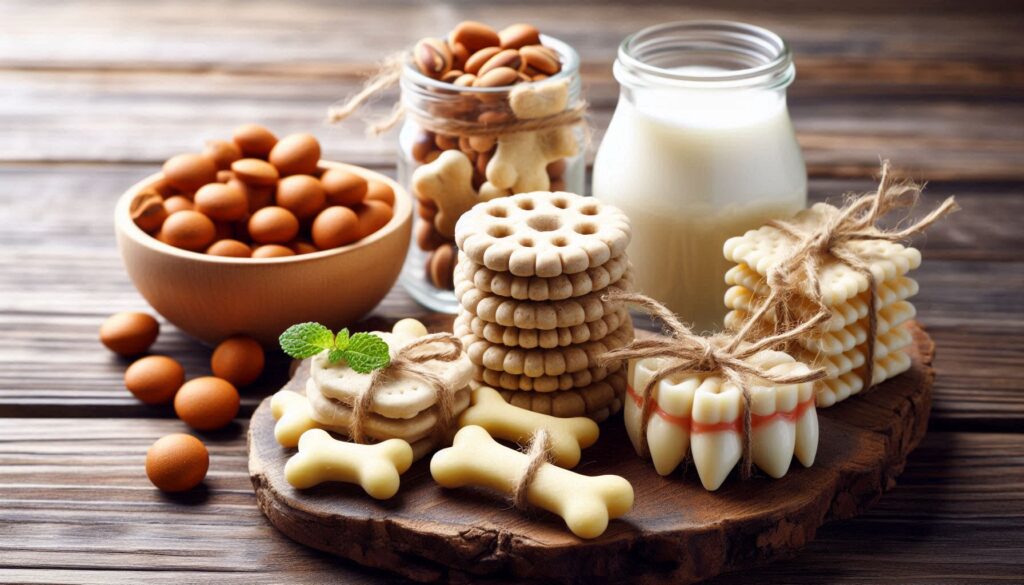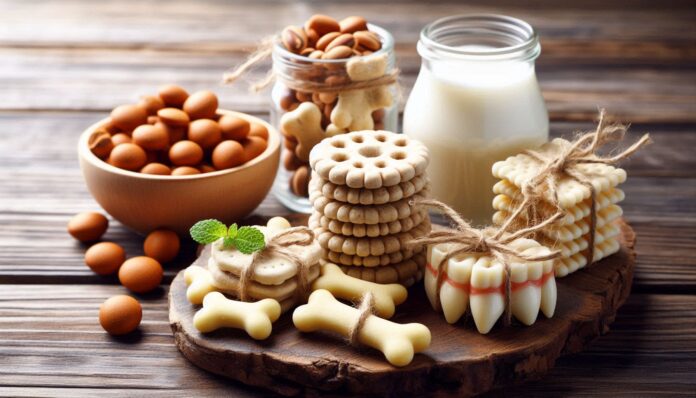As pet parents, we’re always looking for ways to keep our furry friends happy and healthy. One often overlooked aspect of canine wellness is dental health. But fear not! Today, we’re diving into the world of homemade dog treats that not only satisfy your pup’s taste buds but also promote those sparkling canine smiles. Let’s embark on this journey to create some tail-wagging, teeth-cleaning treats that will have your dog begging for more!

Why Dental Health Matters for Your Furry Friend
Before we roll up our sleeves and get cooking, let’s talk about why dental health is crucial for our four-legged companions. Just like humans, dogs can suffer from a variety of dental issues, including:
- Plaque and tartar buildup
- Gingivitis
- Periodontal disease
- Bad breath (halitosis)
These problems can lead to more severe health issues if left unchecked. According to the American Veterinary Medical Association, periodontal disease is one of the most common health problems in dogs, affecting up to 80% of canines by the age of three. Yikes!
But don’t worry – with a combination of regular brushing, professional cleanings, and dental-friendly treats, you can help keep your pup’s chompers in tip-top shape. That’s where our homemade treats come in!
The Benefits of Homemade Dental Treats
You might be wondering, “Why bother making treats at home when I can buy them at the store?” Great question! Here are some compelling reasons:
- Control over ingredients: You know exactly what’s going into your dog’s treats, avoiding any artificial preservatives or additives.
- Cost-effective: Making treats at home can be more economical in the long run.
- Customization: You can tailor recipes to your dog’s preferences and dietary needs.
- Freshness: Homemade treats don’t sit on shelves for months before reaching your pup.
- Bonding experience: Cooking for your furry friend can be a fun and rewarding activity.
Now that we’re all on board with the DIY treat train, let’s get to the good stuff – the recipes!
Recipe 1: Minty Fresh Breath Biscuits
These crunchy biscuits are perfect for freshening your dog’s breath while giving their teeth a good workout.
Ingredients:
- 2 1/2 cups whole wheat flour
- 1/2 cup fresh parsley, finely chopped
- 1/4 cup fresh mint leaves, finely chopped
- 1 egg
- 1/4 cup water
- 3 tablespoons coconut oil (melted)
Instructions:
- Preheat your oven to 350°F (175°C).
- In a large bowl, mix the flour, parsley, and mint.
- In a separate bowl, whisk together the egg, water, and melted coconut oil.
- Gradually add the wet ingredients to the dry mixture, stirring until a dough forms.
- Roll out the dough on a floured surface to about 1/4 inch thickness.
- Cut into desired shapes using cookie cutters.
- Place on a baking sheet lined with parchment paper.
- Bake for 20-25 minutes or until the edges are golden brown.
- Allow to cool completely before serving.
These treats are not only delicious but also pack a punch in the dental health department. Parsley and mint are natural breath fresheners, while the crunchy texture helps scrape away plaque as your dog chews.
Recipe 2: Pumpkin Carrot Crunch Sticks
These veggie-packed sticks are a nutritious treat that also promotes good oral health.
Ingredients:
- 1 cup pumpkin puree (not pumpkin pie filling)
- 1/2 cup finely grated carrots
- 2 eggs
- 2 1/2 cups whole wheat flour
- 1/4 cup water
- 1 tablespoon honey
Instructions:
- Preheat your oven to 350°F (175°C).
- In a large bowl, mix pumpkin puree, grated carrots, and eggs.
- Gradually add flour, water, and honey, mixing until a dough forms.
- Roll out the dough on a floured surface to about 1/4 inch thickness.
- Cut into thin strips (about 1/2 inch wide and 4 inches long).
- Place on a baking sheet lined with parchment paper.
- Bake for 25-30 minutes or until crisp.
- Allow to cool completely before serving.
The fibrous texture of these sticks helps clean teeth as your dog chews, while the carrots provide a natural source of beta-carotene, which is great for overall health.
Recipe 3: Cheesy Dental Delights
For those pups who can’t resist cheese, these treats are a winner!
Ingredients:
- 1 cup whole wheat flour
- 1 cup shredded cheddar cheese
- 1/4 cup plain Greek yogurt
- 1/4 cup chicken broth (low sodium)
- 1 egg
Instructions:
- Preheat your oven to 350°F (175°C).
- Mix all ingredients in a large bowl until a dough forms.
- Roll out the dough on a floured surface to about 1/4 inch thickness.
- Cut into small shapes using cookie cutters.
- Place on a baking sheet lined with parchment paper.
- Bake for 15-20 minutes or until golden brown.
- Allow to cool completely before serving.
The cheese in these treats provides calcium for strong teeth, while the yogurt offers probiotics that can help maintain a healthy oral microbiome.
Incorporating Dental Treats into Your Dog’s Routine
While these homemade treats are fantastic for promoting dental health, they should be used as part of a comprehensive oral care routine. Here are some tips to maximize their effectiveness:
- Moderation is key: Treats should make up no more than 10% of your dog’s daily caloric intake.
- Consistency matters: Offer dental treats regularly, but not as a replacement for meals.
- Pair with brushing: Use treats as a reward after brushing your dog’s teeth to create positive associations.
- Monitor chewing: Ensure your dog chews the treats thoroughly to get the full dental benefits.
- Regular check-ups: Visit your veterinarian for professional dental cleanings and check-ups.
The Human Touch: A Pet Parent’s Perspective
As a fellow dog owner, I can attest to the joy of making treats for my furry friend. There’s something special about watching your pup’s eyes light up when they smell something delicious coming from the kitchen – especially when you know it’s good for them!
I started making homemade dental treats for my Labrador, Max, after noticing he had some mild tartar buildup. Within a few weeks of incorporating these treats into his routine (along with regular brushing), I noticed a significant improvement in his breath and overall oral health.
One tip I’d like to share from personal experience: If your dog is new to homemade treats, start with small batches. This allows you to gauge their preferences and adjust recipes accordingly. Max, for instance, goes absolutely bonkers for the Cheesy Dental Delights, so I always make sure to have a batch on hand!
A Word from the Experts
Don’t just take my word for it – veterinary professionals also advocate for dental health in dogs. Dr. Sarah Thompson, a renowned veterinary dentist, shared her thoughts on homemade dental treats in a recent PetMD article:
“Homemade dental treats can be an excellent addition to a dog’s oral care routine. The act of chewing helps mechanically remove plaque, and when you use ingredients like parsley or mint, you’re also providing natural breath fresheners. However, it’s crucial to remember that treats alone aren’t enough – regular brushing and professional cleanings are still necessary.”
Community Insights: What Other Pet Parents Are Saying
I recently came across a thread on the r/dogs subreddit where pet parents were discussing their experiences with homemade dental treats. Here are a few highlights:
- u/PuppyLover123 shared: “I’ve been making the Minty Fresh Breath Biscuits for my Poodle for months now. Her breath has improved so much, and she absolutely loves them!”
- u/CanineChef wrote: “The Pumpkin Carrot Crunch Sticks are a hit in our house. Even our picky eater can’t resist them. Plus, our vet noticed a difference in their teeth at the last check-up!”
- u/DogMomExtreme commented: “I was skeptical at first, but after trying the Cheesy Dental Delights, I’m a convert. My Chihuahua’s teeth look cleaner, and he’s always excited for treat time now.”
These testimonials from real pet parents reinforce the positive impact that homemade dental treats can have on our furry friends’ oral health.
Addressing Common Concerns
As responsible pet parents, it’s natural to have questions about introducing new elements to our dogs’ diets. Here are some common concerns addressed:
- Allergies: Always consult with your veterinarian before introducing new ingredients, especially if your dog has known allergies or sensitivities.
- Calorie content: While these treats are healthier than many store-bought options, they still contribute to your dog’s daily calorie intake. Adjust meal portions accordingly to maintain a healthy weight.
- Texture preferences: Some dogs may prefer softer treats. If this is the case, you can slightly underbake the treats or add a bit more moisture to the recipes.
- Storage: Homemade treats typically don’t contain preservatives, so store them in an airtight container in the refrigerator for up to a week, or freeze for longer storage.
- Variety: While these recipes are great starting points, feel free to experiment with dog-safe ingredients to keep things interesting for your pup.
Conclusion: A Step Towards Better Canine Dental Health
Embarking on the journey of making homemade dental treats for your dog is a wonderful way to show your love while promoting their health. Not only do these treats offer dental benefits, but they also provide an opportunity for bonding and ensure you know exactly what your furry friend is consuming.
Remember, these treats are just one piece of the puzzle when it comes to canine dental health. Regular brushing, professional cleanings, and a balanced diet all play crucial roles in maintaining those pearly whites.
So, why not give these recipes a try? Your dog’s wagging tail and fresh breath will be all the thanks you need. Here’s to happy, healthy smiles for our canine companions!
FAQs About Homemade Dog Treats for Dental Health
1. Can I use regular flour instead of whole wheat flour in these recipes?
While you can use regular all-purpose flour, whole wheat flour is generally a healthier option for dogs. It contains more fiber and nutrients compared to white flour. If your dog has a wheat sensitivity, you could try alternatives like coconut flour or oat flour, but be aware that this may change the texture and baking time of the treats.
2. How often should I give my dog these dental treats?
The frequency depends on your dog’s size, overall diet, and dental health needs. As a general rule, one or two small treats per day is usually sufficient. Always remember that treats should make up no more than 10% of your dog’s daily caloric intake. It’s best to consult with your veterinarian to determine the ideal treat schedule for your specific pup.
3. Are there any ingredients I should avoid when making homemade dog treats?
Absolutely! Some human foods can be harmful or even toxic to dogs. Always avoid using:
- Chocolate
- Xylitol (an artificial sweetener)
- Onions and garlic
- Grapes and raisins
- Macadamia nuts
- Avocado
- Alcohol
When in doubt, always research an ingredient or consult with your vet before including it in your homemade treats.
4. Can puppies eat these dental treats?
While these treats are generally safe for adult dogs, puppies have different nutritional needs and more sensitive digestive systems. It’s best to wait until your puppy is at least 6 months old before introducing homemade treats, and always start with small amounts to see how they react. For puppies, you might want to focus on softer treats that are easier on their developing teeth.
5. How do I know if the dental treats are actually improving my dog’s oral health?
Look for these signs of improvement:
- Fresher breath
- Less visible plaque or tartar on teeth
- Healthier-looking gums (pink rather than red or inflamed)
- Increased willingness to have their mouth touched
However, the most reliable way to assess your dog’s dental health is through regular check-ups with your veterinarian. They can provide professional evaluations and cleanings as needed.
Remember, while these treats can contribute to better dental health, they’re not a substitute for regular tooth brushing and professional dental care. Use them as part of a comprehensive oral health routine for the best results!


